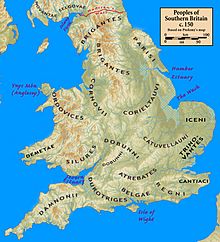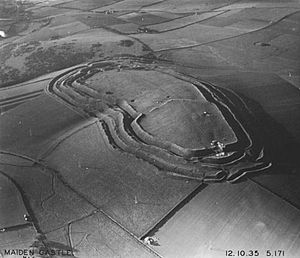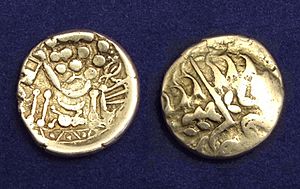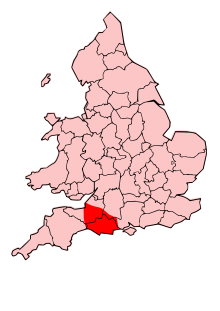Durotriges facts for kids
Quick facts for kids Durotriges |
|
 |
|
| Geography | |
| Capital | Durnovaria (Dorchester) Dunium (Hengistbury Head) |
|---|---|
| Location | Dorset South Wiltshire South Somerset Devon |
| Rulers | None known |
The Durotriges were an ancient Celtic tribe who lived in Britain a long time ago. They were around before the Romans came to Britain. Their home was in what is now Dorset, south Wiltshire, south Somerset, and parts of Devon.
In 2009, a collection of old Iron Age items was found on the Isle of Wight. This suggests the Durotriges might have also lived in the western part of that island. After the Romans took over, the main towns for the Durotriges were Durnovaria (today's Dorchester) and Lindinis (modern Ilchester). To their west lived the Dumnonii tribe, and to their east were the Belgae.
Contents
Who Were the Durotriges?
We know the name of this tribe, Durotriges, from an old book called Ptolemy's Geography. We also found their name on two stone carvings on Hadrian's Wall. These carvings were made after the Romans arrived in Britain. We don't know if people called them Durotriges before the Romans came to the area we now call Dorset.
The name "Durotriges" likely has two parts. "Duro" means "hard" or "strong place." This word was often used for early Roman forts. "Trig" means "inhabitant." So, the name could mean "fort dwellers." This makes sense because their land had many hill forts. However, most of these forts were not used much by the time the Romans invaded in 43 AD.
Another idea is that "Duro" comes from "dubro," an old British word for water. And "riges" might mean "kings." So, it could also mean "water kings."
Where Did the Durotriges Live?
Historians figure out where the Durotriges lived by looking at where their coins are found. Interestingly, not many Durotrigan coins are found in their main area. This might be because they were melted down and made into new coins there.
To the north and east of the Durotriges were the Belgae tribe. The Avon River and its branch, the Wylye, formed the border between them. This old boundary is still seen today in the county line between Wiltshire and Somerset.
The Durotriges traded a lot across the English Channel, especially in the first half of the 1st century BC. This is when they started using the potter's wheel to make pottery. Their main trading port was at Hengistbury Head. However, trade slowed down in the years before the Romans arrived. Their coins also started to have less valuable metal in them. This suggests their economy was getting weaker, and they were becoming more cut off from other cultures.
The Durotriges might have been a group of tribes working together, rather than just one single tribe. They were one of the groups that made their own coins before the Romans came. These coins were quite simple and didn't have any writing on them. So, we don't know the names of any rulers or kings from their coins.
The Durotriges had a settled society. They lived by farming the land, which was often surrounded by large hill forts. Most of these hill forts were no longer used by 100 BC, long before the Roman army, led by Vespasian, arrived in 43 or 44 AD. Maiden Castle is a famous example of one of these ancient hill forts.
Durotriges Settlements

It's hard to know the exact names of all the places where the Durotriges lived before the Romans arrived. This is because their leaders and families became part of the Roman way of life. But we do know about several places from different sources.
Ptolemy's Geography mentions Dunium, which some think was Hengistbury Head. This was an important center near their neighbors, the Belgae. However, we don't know if it was the main capital for all the Durotriges. Other places seem to have been just as important based on what archaeologists have found.
Some known places where the Durotriges lived before the Romans include:
- Maiden Castle
- Cadbury Castle
- Ham Hill
- Hod Hill
- Pilsdon Pen
- Duropolis
Durotriges Culture and Roman Arrival
The Durotriges buried their dead by laying them in the ground. They often placed the bodies in a crouched position in shallow, oval graves. Sometimes, they even included a final meal for the person, even in difficult times. For example, at Maiden Castle, eight burials were found that happened right after a Roman attack.
In 2010, the burial of a young Durotrigian woman was found at Langton Herring in Dorset. She was buried with a decorated mirror. Scientists used radiocarbon dating to find out she was buried between 25 AD and 53 AD.
For a long time, people thought the Durotriges fought very hard against the Roman invasion in 43 or 44 AD. A Roman writer named Suetonius wrote about battles between southern British tribes and the Roman army. However, we don't know for sure if the Durotriges were specifically involved.
An archaeologist named Mortimer Wheeler studied Maiden Castle in the 1930s. He thought a cemetery found there showed a brutal Roman attack. But later studies in the 1980s and 2015 showed that Wheeler's idea of a big battle and massacre was probably not correct. By about 70 AD, the Durotriges were already starting to adopt Roman ways and were part of the Roman province of Britannia. In their area, the Romans also used local stone quarries and supported the making of pottery.
Today, researchers from Bournemouth University are still studying the Durotriges and how they interacted with the Roman Empire. This project, called The Durotriges Project, started in 2009. They are looking closely at the time when the Iron Age changed into the Roman period. They do this by surveying the land, using special equipment to look underground, and carefully digging up sites. So far, they have focused on an old Iron Age settlement with roundhouses and storage pits, an Iron Age cemetery, two Roman villas, and a large Iron Age settlement called Duropolis.
See also
- Abbotsbury Castle
- Castle Rings, Wiltshire
- List of Celtic tribes



